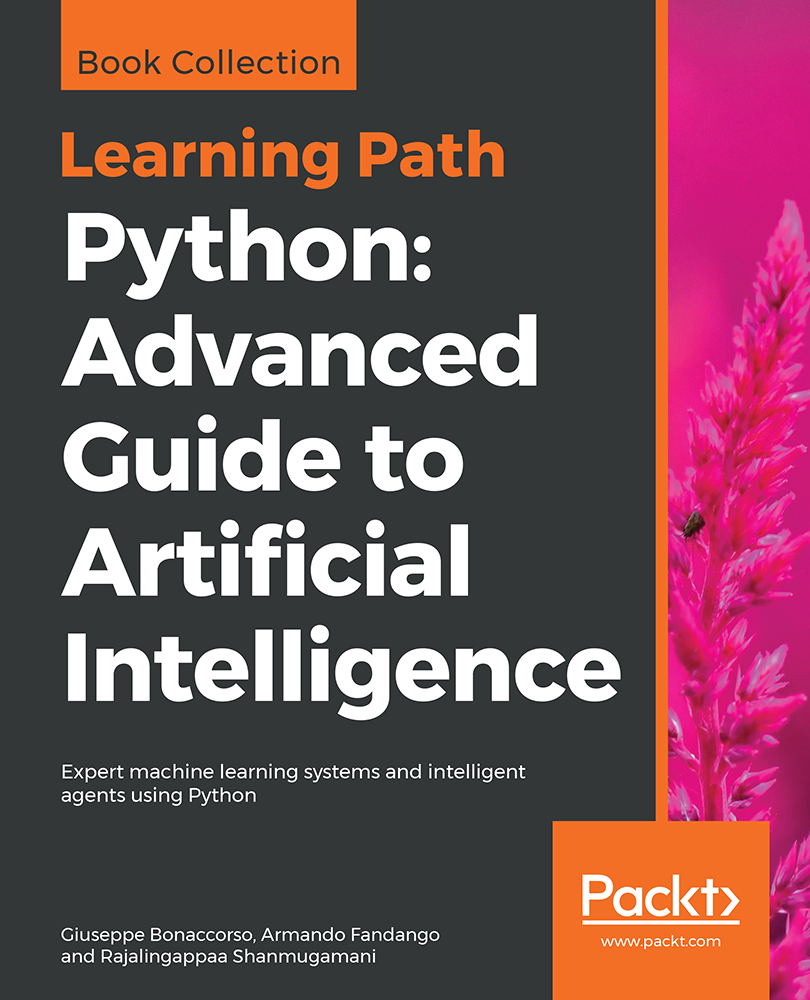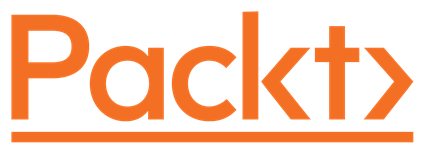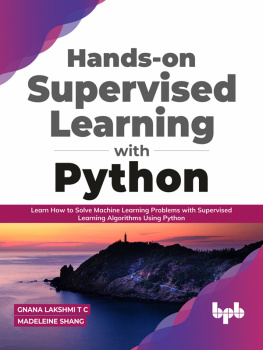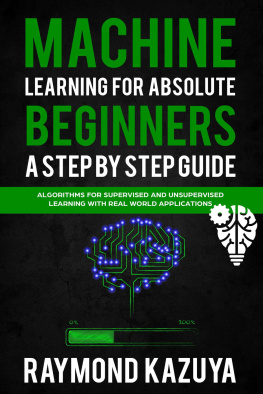
Python: Advanced Guide to Artificial Intelligence
Expert machine learning systems and intelligent agents using Python
Giuseppe Bonaccorso
Armando Fandango
Rajalingappaa Shanmugamani

BIRMINGHAM - MUMBAI
Python: Advanced Guideto Artificial Intelligence
Copyright 2018 Packt Publishing
All rights reserved. No part of this book may be reproduced, stored in a retrieval system, or transmitted in any form or by any means, without the prior written permission of the publisher, except in the case of brief quotations embedded in critical articles or reviews.
Every effort has been made in the preparation of this book to ensure the accuracy of the information presented. However, the information contained in this book is sold without warranty, either express or implied. Neither the authors, nor Packt Publishing or its dealers and distributors, will be held liable for any damages caused or alleged to have been caused directly or indirectly by this book.
Packt Publishing has endeavored to provide trademark information about all of the companies and products mentioned in this book by the appropriate use of capitals. However, Packt Publishing cannot guarantee the accuracy of this information.
First published: December 2018
Production reference: 1191218
Published by Packt Publishing Ltd.
Livery Place
35 Livery Street
Birmingham
B3 2PB, UK.
ISBN 978-1-78995-721-1
www.packtpub.com
mapt.io
Mapt is an online digital library that gives you full access to over 5,000 books and videos, as well as industry leading tools to help you plan your personal development and advance your career. For more information, please visit our website.
Why subscribe?
Spend less time learning and more time coding with practical eBooks and Videos from over 4,000 industry professionals
Improve your learning with Skill Plans built especially for you
Get a free eBook or video every month
Mapt is fully searchable
Copy and paste, print, and bookmark content
Packt.com
Did you know that Packt offers eBook versions of every book published, with PDF and ePub files available? You can upgrade to the eBook version at www.packt.com and as a print book customer, you are entitled to a discount on the eBook copy. Get in touch with us at customercare@packtpub.com for more details.
At www.packt.com , you can also read a collection of free technical articles, sign up for a range of free newsletters, and receive exclusive discounts and offers on Packt books and eBooks.
Contributors
About the authors
Giuseppe Bonaccorso is an experienced team leader/manager in AI, machine/deep learning solution design, management, and delivery. He got his MScEng in electronics in 2005 from the University of Catania, Italy, and continued his studies at the University of Rome Tor Vergata and the University of Essex, UK. His main interests include machine/deep learning, reinforcement learning, big data, bio-inspired adaptive systems, cryptocurrencies, and NLP.
Armando Fandango is an accomplished technologist with hands-on capabilities and senior executive level experience with startups and large companies globally. Armando is spearheading Epic Engineering and Consulting Group as Chief Data Scientist. His work spans across diverse industries including FinTech, Banking, BioInformatics, Genomics, AdTech, Utilities and Infrastructure, Traffic and Transportation, Energy, Human Resource, and Entertainment.
Armando has worked for more than ten years in projects involving Predictive Analytics, Data Science, Machine Learning, Big Data, Product Engineering and High-Performance Computing. His research interests span across machine learning, deep learning, algorithmic game theory and scientific computing. Armando has authored book titled Python Data Analysis - Second Edition and published research in international journals and conferences.
Rajalingappaa Shanmugamani is currently working as a Engineering Manager for a Deep learning team at Kairos. Previously, he worked as a Senior Machine Learning Developer at SAP, Singapore and worked at various startups in developing machine learning products. He has a Masters from Indian Institute of Technology Madras. He has published articles in peer-reviewed journals and conferences and applied for few patents in the area of machine learning. In his spare time, he coaches programming and machine learning to school students and engineers.
Packt is searching for authors like you
If you're interested in becoming an author for Packt, please visit authors.packtpub.com and apply today. We have worked with thousands of developers and tech professionals, just like you, to help them share their insight with the global tech community. You can make a general application, apply for a specific hot topic that we are recruiting an author for, or submit your own idea.
Preface
This Learning Path is your complete guide to quickly getting to grips with popular machine learning algorithms. You'll be introduced to the most widely used algorithms in supervised, unsupervised, and semi-supervised machine learning, and learn how to use them in the best possible manner. Ranging from Bayesian models to the MCMC algorithm to Hidden Markov models, this Learning Path will teach you how to extract features from your dataset and perform dimensionality reduction by making use of Python-based libraries.
You'll bring the use of TensorFlow and Keras to build deep learning models, using concepts such as transfer learning, generative adversarial networks, and deep reinforcement learning. Next, you'll learn the advanced features of TensorFlow1.x, such as distributed TensorFlow with TF clusters, deploy production models with TensorFlow Serving. You'll implement different techniques related to object classification, object detection, image segmentation, and more.
By the end of this Learning Path, you'll have obtained in-depth knowledge of TensorFlow, making you the go-to person for solving artificial intelligence problems
This Learning Path includes content from the following Packt products:
- Mastering Machine Learning Algorithms by Giuseppe Bonaccorso
- Mastering TensorFlow 1.x by Armando Fandango
- Deep Learning for Computer Vision by Rajalingappaa Shanmugamani
Who this book is for
This Learning Path is for data scientists, machine learning engineers, artificial intelligence engineers who want to delve into complex machine learning algorithms, calibrate models, and improve the predictions of the trained model.
You will encounter the advanced intricacies and complex use cases of deep learning and AI. A basic knowledge of programming in Python and some understanding of machine learning concepts are required to get the best out of this Learning Path.
What this book covers
, Machine Learning Model Fundamentals, explains the most important theoretical concepts regarding machine learning models, including bias, variance, overfitting, underfitting, data normalization, and cost functions. It can be skipped by those readers with a strong knowledge of these concepts.
Next page






